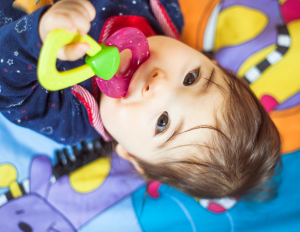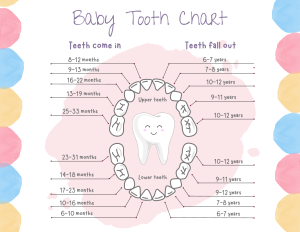Teething
I remember clearly when my oldest daughter, now 33 years old, was teething. She had already gotten her two lower front teeth, and one day she started to get cranky, and lo and behold, her top teeth were trying to come through. But it was not just one or two teeth. It was all four of her upper front teeth coming in at the same time! Poor thing, she was not a happy toddler, to say the least.
 For those of you who have had older kids who have gone through this, you know it can be difficult to see your child feeling discomfort. Teething can be a source of stress for everyone. It can interrupt much-needed sleep and make you and your child’s usual sunny attitude much stormier. Finding ways to deal with this temporary discomfort can help the whole family. Even in older children, there can be issues when losing their baby teeth and getting their adult teeth. Read on to learn more about both.
For those of you who have had older kids who have gone through this, you know it can be difficult to see your child feeling discomfort. Teething can be a source of stress for everyone. It can interrupt much-needed sleep and make you and your child’s usual sunny attitude much stormier. Finding ways to deal with this temporary discomfort can help the whole family. Even in older children, there can be issues when losing their baby teeth and getting their adult teeth. Read on to learn more about both.
Teething is a normal part of childhood, and your child’s first teeth should come in (or erupt) around six months of age, but it can start as early as four months old. Some kids do not get their first tooth until 12-14 months, so do not fret if there are no teeth by the first birthday. And all baby teeth should be finished erupting by age three. For kids with Down Syndrome, the first tooth does not come in until much later, at about 24 months, and they do not get all their baby teeth until about age five.

Some of the signs your baby is getting ready to teethe:
- Excessive drooling can start a couple of months before the first tooth appears.
- Your baby will likely want to chew or “gum” toys or other items.
- Your baby will likely put their hands and fingers in their mouth.
Actual teething happens when the teeth are about to come through the gums and when they do come through. The signs can include:
- Red sore gums
- Irritability
- Continued drooling
- Loss of appetite
- Interrupted sleep
Although less common in babies, little ones can develop a fluid-filled sac on top of where the emerging tooth will be. This sac is called an eruption cyst and usually is nothing to worry about. It occurs more often in an older child when an adult tooth comes in, about age 6-9, but it still can happen with babies. It can be pink, reddish, or even bluish/ purple if blood is mixed in the sac. For reasons unknown, sometimes a bubble will grow on top of the erupting tooth. It looks worse than it feels, usually the same discomfort as any other erupting tooth. However, it can be tender if your child chews on the area.
In most cases, the tooth will just come through, the cyst will break, and there is nothing else you need to do. Sometimes the sac will not break, or it might become infected, and that is when it is a good time to see your dentist. If an eruption cyst lasts more than a couple of weeks, contact your dentist to have it checked.
 So, what can you do to help your little ones go through this normal part of growing? The first step is understanding that they will get through it and not take too long. There is a myth that a rash, diarrhea, or fever is part of teething, but these ideas are not accurate, and if your child has any of those symptoms when they are teething, it is something else they are fighting off. This is when you will want to contact your pediatrician or primary care provider to decide what to do.
So, what can you do to help your little ones go through this normal part of growing? The first step is understanding that they will get through it and not take too long. There is a myth that a rash, diarrhea, or fever is part of teething, but these ideas are not accurate, and if your child has any of those symptoms when they are teething, it is something else they are fighting off. This is when you will want to contact your pediatrician or primary care provider to decide what to do.
Use:
- Cold and pressure can be extremely helpful to lessen the discomfort from teething.
- You might want to try chilling a teether in the refrigerator but do not freeze teethers or other items, as they can be too cold and cause more harm.
- Make sure that the teethers are clean and that there are no areas where it is broken or torn.
- If you want to give your baby a pain reliever, find out what the pediatrician recommends.
- Use a clean finger or wet gauze on the finger and rub the gums.
- Use a clean wet washcloth and chill in the refrigerator and rub on the gums.
- Here are some great teethers and other products recommended by Melanie Potock, MA, CCC-SLP
Do not use:
- Teething gels do not work well since the extra saliva or drool will dilute and wash them away.
- Over-the-counter products with lidocaine or benzocaine can be harmful to babies and young children.
- Homeopathic teething tablets can have varying amounts of active ingredients, making it difficult to know how much your child will get. Always ask your pediatrician what to use.
- Using teething necklaces or bracelets is not recommended as they can be dangerous, increasing the risk of choking.
- Although tempting, do not put honey, sugar, or another sweetener on the teething ring.
You can find more information at:
Mayo Clinic: Tips for soothing sore gums
American Academy of Pediatrics: Teething & Tooth Care